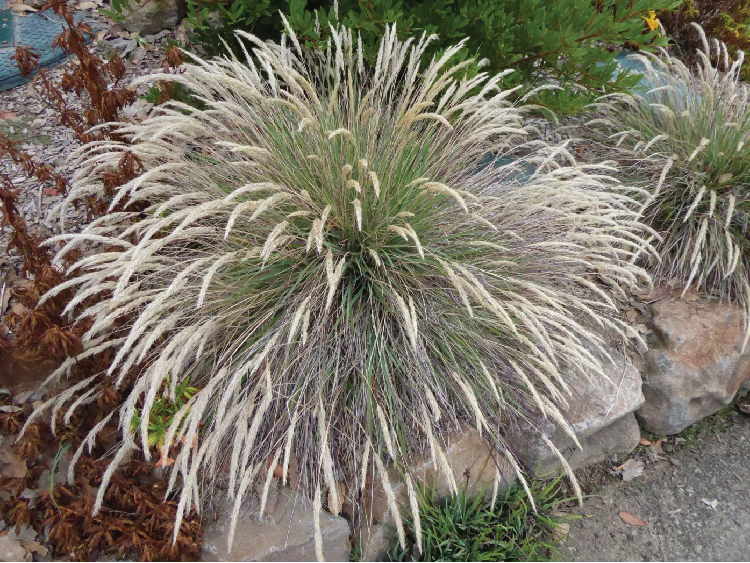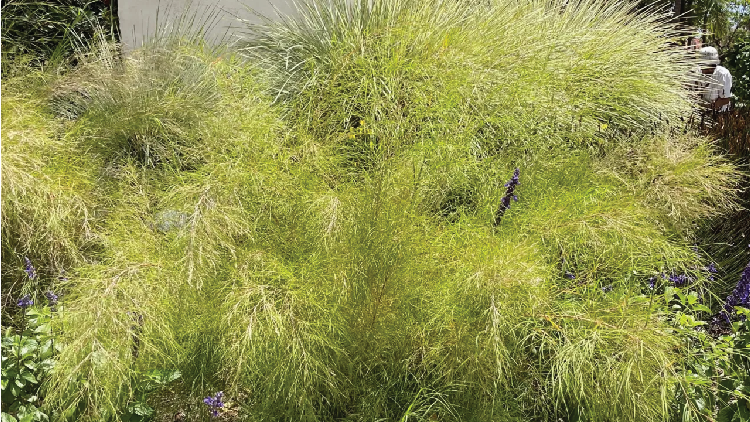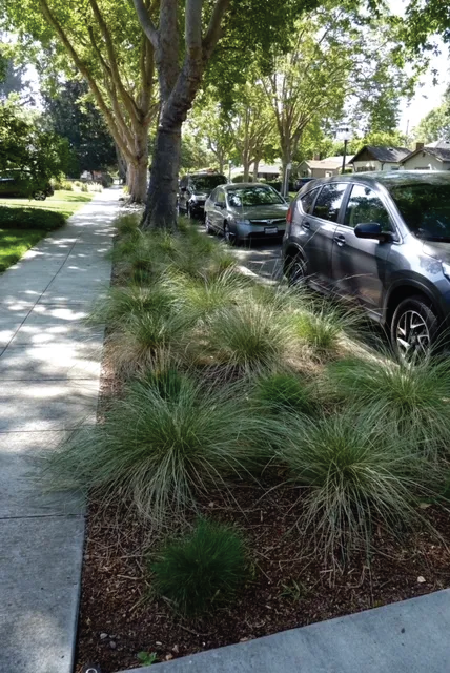California native grasses bring ‘natural’ into home landscapes

Leavy Reed Grass (Zoya Akulova)
By Sherry Goldman
(This article originally appeared in the September16, 2024 issue of the San Diego Union-Tribune)
For many of us, the world we live in has become so complex and fast-paced that we seek out ways to relax and recharge. Perhaps, in response to this, one of the new trends in contemporary landscaping and gardening is creating a more naturalistic landscape, rich in varieties of native plants and perennials, often with splashes of color from annual wildflowers. The placement and pruning of plants is “naturalistic” and the emphasis is to be earth-friendly and to attract and support local garden wildlife.
Nature-oriented gardens like these have as many names as the plants within but are most commonly referred to as “meadowscaping,” “wildscaping,” “habitat gardening” or “urban oasis.” Having a garden or landscape like this can reflect the wild places you would like to visit or have visited and a longing to connect to the rhythms of nature. “Bringing nature home” can promote feelings of comfort and serenity and satisfy desires for purpose and fulfillment.
Ornamental grasses are an integral feature of these types of naturalistic landscapes and gardens and can be the stars of the show. Magazines and articles feature glossy photos of grasses, massed on slopes, billowing in the wind, or exotically colored clumps of grasses standing as stately backdrops or mixed with colorful perennials. Whatever the overall composition, John Greenlee, a so-called grass guru and author of the book “Meadows by Design,” writes that “… grass is the glue that holds it all together.”

Bamboo muhly (Muhlenbergia dumosa) is used here as a 4-foot screen. (Sherry Goldman)
However, many of the exotic and colorful grasses seen and coveted are actually not native to California. They originated outside the U.S. and were naturalized here. Beautiful as they may be, many of these imports are problematic. Those that are prolific seeders, whose seeds easily germinate, can become invasive and establish themselves in new habitats. They displace native plants and wildlife, causing biodiversity loss, and increase the chances of wildfires, floods and landslides.
A beneficial alternative to these non-natives can be California native grasses, Indigenous to our region, which have evolved over the ages to live in harmony with our particular environment. They attract and support pollinators, butterflies and local garden wildlife by providing cover, nesting materials, water and food sources. Their deep roots equip them to be quite drought tolerant, act as carbon sinks to help store carbon in the soil, increase water infiltration, retain soil and reduce erosion. The environment reaps the benefits of reduced fertilizer and pesticide use. The Trees Foundation reports that “the restoration of native grasses and the reduction of invasive ones could reduce the frequency and intensity of fires”.
Gardening with native grasses creates the opportunity to rebuild the natural habitat of your region and increase biodiversity. Sweeping meadows covering undulating hills and valleys is part of the history of California. Yet today, the California Native Grasslands Association reports that “Agriculture, invasion by exotic species, development, and other human-related activities have reduced California native grasslands by 99%.”
If you’ve now become interested in adding native grasses to your garden repertoire, you will be happy to hear that they are some of the easiest natives to grow, if they are planted and maintained with their specific characteristics and needs in mind.
Do your homework in advance and ask for advice. There are nurseries in San Diego County specializing in native plants with staff who are knowledgeable and eager to help. Many other nurseries have sections devoted to native perennials and grasses. Information can also be obtained from the Master Gardener Association of San Diego. Advice can be priceless.
Here are some of my favorite ornamental native grasses:
Deer grass (Muhlenbergia rigens)

Deer grass (Muhlenbergia rigens) provides an eye-catching, easy-care planting option in a strip of land between sidewalk and roadway. (2020 Jean Pawek)
Praised as “architectural,” “dramatic,” beautiful when planted solo or in a grouping, long, thin blades arch fountainlike in a mound 3 feet high and 4 feet wide. In summer, tawny flower stalks, radiating outward, carry flower heads 3 to 4 feet higher. This is a fast-growing warm-season, bunchgrass (clumping), easily grown in nearly any soil in full sun. It is drought tolerant when established but summer irrigation keeps foliage green.
Bamboo muhly (Muhlenbergia dumosa)
An unusual, fun and interesting evergreen grass for a sunny spot, it looks like a dainty bamboo with light, airy, bright green foliage 4-6 ft. high by 3-5 ft. wide that dances in the wind. The delicacy of this grass belies its low water needs. It spreads slowly by underground rhizomes but is easily controlled. It can make a good low screen and even looks beautiful in a pot.
Leafy reed grass (Calamagrostis foliosa)
Beautiful arching mounds of blue-grey blades tinged with purple highlights decorate this 1 foot high by 2 feet wide native. The size and form make it an excellent accent in a rock garden, or massed in a perennial border, meadow, or slope. It does best in a coastal climate, tolerates wind and salt, and moderate to occasional water.
Goldman has been a UC Master Gardener of San Diego County since 2014. She enjoys working in the backyard meadow of her Carlsbad home.

